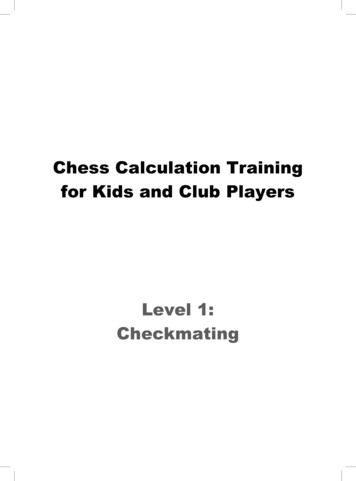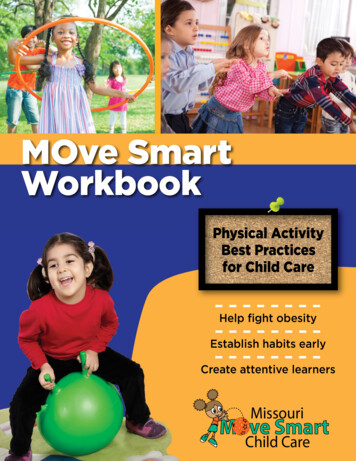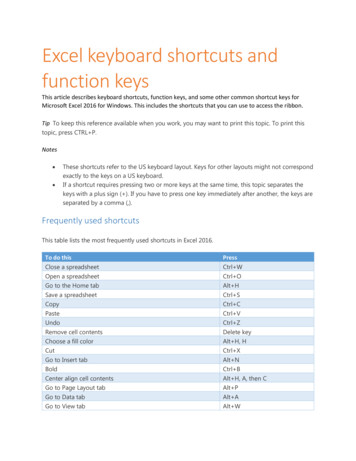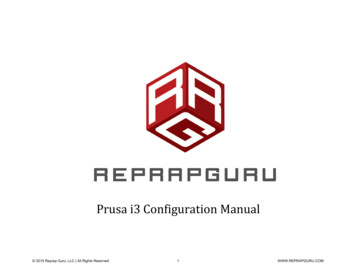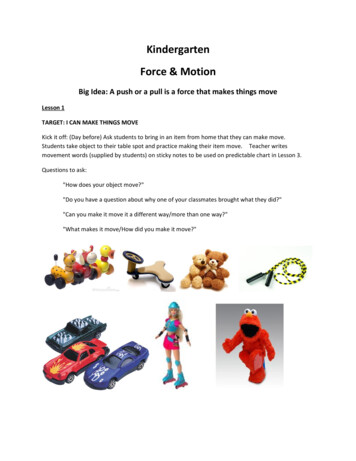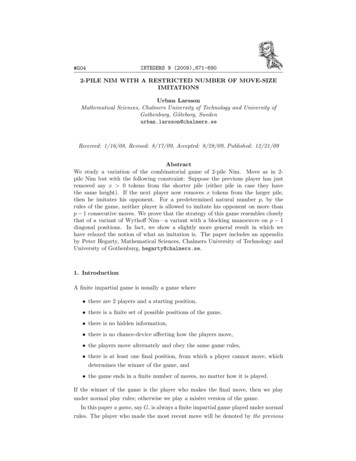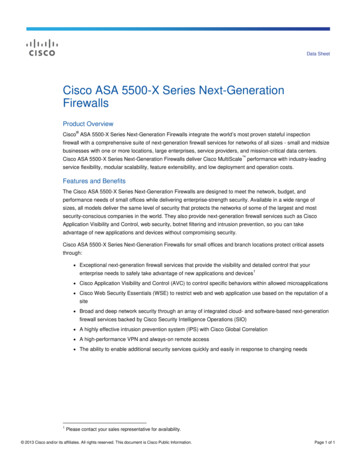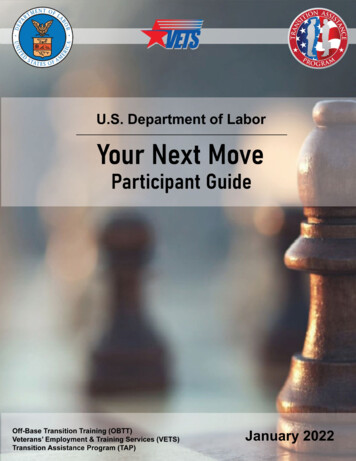
Transcription
Your Next MoveParticipant GuideTable of ContentsIntroduction . 4Learning Objectives .5Workshop Overview .6PERSONAL FACTORS . 6Section 1 – Personal Factors in Career Search . 6Factors to Consider When Selecting a Career .7Section 2 – O*NET Interest Profiler and Self-assessments . 9Self-assessments .9What Is an Assessment? . 10Career Research Worksheet . 11Interest Profiler . 11Website Activity: O*NET Interest Profiler . 12Work Types . 156 Work Types – Interest Areas. 165 Job Zones . 17Website Activity: O*NET Results . 19Job Details . 20Section 3 – CareerOneStop Skills Matcher. 30Skills . 30Hard and Soft Skills Brainstorm Activity . 31CareerOneStop . 33CareerOneStop Skills Matcher . 34Website Activity: Use CareerOneStop to show Skills Matcher . 34Career Details. 41Website Activity: Show Skills Matcher Career Details . 41Website Activity – Explore Two Careers . 46ENVIRONMENTAL FACTORS . 52Section 4 – Why is Labor Market Information Important? . 52LMI Can Be Used to Answer Questions . 52Page 2
Your Next MoveParticipant GuideLabor Market Information Research . 53Useful Terms to Understand . 54Why care about industries? . 55Compare Occupations . 56Website Activity: Use CareerOneStop to compare occupations. . 56LMI: Salary and Cost of Living . 62American Job Center . 63Additional Transition Assistance Program Workshops . 64DOL Employment Workshop (DOL EW) . 64Managing Your (MY) Education . 65Career and Credential Exploration (C2E). 65Boots to Business Entrepreneurship Workshop. 65In Conclusion . 65Appendix . 67Career Research Worksheet Section . 67MyNextMove Interest Profiler Scores . 67MyNextMove Interest Profiler Job Details . 68My Hard Skills and Soft Skills Self-Assessment . 72CareerOneStop Skills Matcher Top Six Skills . 72CareerOneStop Occupation Comparison . 73My Employment History Outline . 75Page 3
Your Next MoveParticipant GuideIntroductionWelcome to the Your Next Move workshop. This two-hour workshop is provided by theDepartment of Labor (DOL) to veterans, including those veterans currently serving in theReserve Component (National Guard and Reserve members), and their spouses seekinginformation on how to evaluate careers and to develop a plan to achieve a desiredcareer.Determining what kind of career is the best choice involves assessing yourself andevaluating careers, looking introspectively and externally, and using your time andresources wisely.The purpose of this workshop is to provide you with resources and information you canuse to evaluate careers and to develop a plan to achieve your desired career.“If you know the enemy and you know yourself,you need not fear the results of a hundred battles.” Sun Tzu, Chinese military general, philosopher, and author of The Art of War.Think about how you could restate this quote by substituting the word enemy with otherwords:“If you know the job market and you know yourself,you need not fear the results of a hundred interviews.”How else might you restate this quote?Page 4
Your Next MoveParticipant GuideLearning ObjectivesAt the end of this section, you will be able to: Describe personal factors in identifying your career choice.Explore DOL resources, such as My Next Move and CareerOneStop, which providean external evaluation of careers and assessment tools to assist you in identifyingcareers which match your interests, knowledge, skills, and abilities.Explain three reasons to conduct LMR. First it helps you understand an occupation’soutlook in the U.S. market, then it helps you identify salary ranges, and third it helpsyou determine how to spend your funds on work-related training and education.Recognize additional opportunities for self-assessment such as attending the DOLCareer and Credential Exploration (C2E) two-day workshop in person or online atTAP Virtual Curriculum https://www.tapevents.org/courses. Attending this workshopwill provide you with information and a range of tools and resources to help youevaluate your career options and gain the necessary training or credentials needed topursue your vocational career goals.Page 5
Your Next MoveParticipant GuideWorkshop OverviewThis workshop is divided into two sections - Personal Factors and Environmental Factors.As each section is covered, not only will there be an opportunity for discussions, but youwill also complete two assessments and some LMI research.You will use the O*NET Interest Profiler to assess your interests, values, and work style.The CareerOneStop Skills Matcher assessment is used to identify your skills andexperience as related to careers and occupations that may be right for you.As you review the career suggestions these tools provide, think about your personalpriorities, and look for common themes among the results. Think about how therecommendations can help you find a career where your interests, skills, and salaryrequirements connect.PERSONAL FACTORSSection 1 – Personal Factors in Career SearchPlanning Your Next StepsIn this section, you will explore how personal factors may affect a career choice.What will your next move be? What strategies will you use in your career search? Willyou continue in your current career or pursue a new one which has a bright outlook?Page 6
Your Next MoveParticipant Guide“Avoid the crowd. Do your own thinking independently.Be the chess player, not the chess piece. Ralph Charell (1929-present), American former stockbroker from Manhattan and theauthor of the book 'How to Make Things Go Your Way'.Factors to Consider When Selecting a CareerWhen selecting a career, think about the following seven factors:Interests. Pursue something you are truly interested in.If you do not like working with sick people, do not be pressured into becoming anurse just because there is a high demand for nurses.Values. Make a list of your top priorities to ensure this career matches up, as you plan foryour future career.How will you achieve a work-life balance?Is having weekends off important?Work Style. Ensure the career path you choose provides you with an environment you can thrivein.Everyone has their own unique work style.Page 7
Your Next Move Participant GuideSome enjoy deadlines and structure while others thrive with little guidance or directsupervision.Location. Consider housing availability, associated moving costs, cost of living, and familyadjustment.Is the job in demand where you are going to live, or do you need to relocate?The Market. Research the labor market to ensure the career you are pursuing has demand in yourarea and to determine what education or training is required.Research the salary ranges, industry trends, and growth potential.Education and Training (High-Quality Career). Select a career where you can utilize your knowledge, skills, and abilities in anoccupation that supports your values while earning a substantive wage.According to the DOL’s Bureau of Labor Statistics, individuals with an associatedegree, on average, earn 18% more than their counterparts with high schooldiplomas.Likewise, an individual with a bachelor’s degree, on average, earns 64% more.Individuals who complete a Registered Apprenticeship Program, on average, earn84% more than those with only a high school diploma.Skills. Consider the skills necessary for the career you select.Do you already have these skills?Are there skills you need to develop to be a competitive candidate in that field?So, now that we have discussed a little about personal factors in career searches, let’sconduct a self-assessment.Page 8
Your Next MoveParticipant GuideSection 2 – O*NET Interest Profiler and SelfassessmentsThere are many aspects that go into career planning: interests, values, and aptitudes, aswell as “practical matters” such as market, salary, location, etc. In this section, we willcover how to use the O*NET Interest Profiler to assess your interests, values, and workstyle.Self-assessmentsAcquiring self-knowledge through assessments will assist in developing plans to reachyour desired career.In this section, we will review your first assessment, the O*NET Interest Profiler, which isdesigned to measure your interests, aptitudes, and work values.Even if you already know what career you want to pursue, personal assessments canoffer you a deeper understanding of how to best position yourself for success. As youreview the career suggestions this and other tools provide, think about how these selfassessments can: Assist in developing plansExplore occupations that match your interestsRecommend suitable occupationsPage 9
Your Next MoveParticipant GuideWhat Is an Assessment?Evaluation and assessment are words you often hear used together because each canbe used in defining the other. An evaluation is used to grade or gauge the quality ofsomething applied against standards to help you understand performance so you canidentify possible shortfalls. An assessment documents and measures individualknowledge, skills, and abilities and provides feedback used to help determine whichstrategies to implement to determine your next steps.Career assessment is the process of evaluating how a variety of personal attributes suchas your interests, values, and aptitudes impact your potential success and satisfactionwith different career options and work environments. Career assessments are notconsidered tests because there are no right or wrong answers. The assessments takeinto consideration how high you score in various careers based on your answers toquestions pertaining to your interests, skills, personality traits, and values.While assessments are great tools to help you narrow down your career options, anassessment cannot determine the perfect career for you. Career assessments havelimitations, so you might need to consider a variety of tools and resources to select acareer that is the best fit for you. An assessment can certainly help you get started, butyou still need to carefully consider the pros and cons of any occupation that interestsyou.Page 10
Your Next MoveParticipant GuideCareer Research WorksheetThroughout this workshop, you will complete sections of the Career Research Worksheetand record career information, such as job details, your knowledge, skills, and abilities,and salary ranges to help you plan your next steps. Located in the Appendix are all of theCareer Research Worksheet pages.In the following website activity, you will use the O*Net Interest Profiler, and record yourInterest Profiler scores in the first section.Interest ProfilerPage 11
Your Next MoveParticipant GuideThis assessment will identify your dominant work type. It has four sections: Interests,Results, Job Zones, and Careers.Use this information to find out what interests you and how these interests can relate to acareer.Website Activity: O*NET Interest ProfilerUse the following steps to complete the O*NET Interest Profiler activity.First, access the O*NET Interest Profiler at www.mynextmove.org/explore/ip. Select Startin the lower left-hand corner of the screen. Move through the Interest Profiler explanationscreens until you reach the www.mynextmove.org/explore/ipsection.In the Interests section, you will answer all 60 questions to assess how you would feelabout different work activities.Your answers should be based ONLY on how you would feel about doing these activitiesand NOT on your experience level, training, ability, or earning potential.Page 12
Your Next MoveParticipant GuideIt is important to remember that there are no wrong or right answers, only your opinionmatters.Once you finish answering all 60 questions, select Next to continue to your InterestProfiler results.In the Results section, on the left-hand column, each of the six work types/interests willhave a numerical ranking.You can select any of the six interest areas to read its description. Your three strongestinterests will be in bold.In the example, the numerical ratings are:Realistic – 9Investigative – 27Page 13
Your Next MoveParticipant GuideArtistic – 12Social – 16Enterprising – 26Conventional – 12The individual’s three strongest interest areas, or those with the highest number, areArtistic, Social, and Conventional. They would identify as ASC.Record your Interest Profiler scores from the O*Net Interest Profiler,https://www.mynextmove.org/explore/ip in the following ocialEnterprisingConventionalTo view your report later, you can select Enter Scores on the Interest Profiler homepage without having to retake the entire questionnaire.Page 14
Your Next MoveParticipant GuideWork TypesThe O*NET Interest Profiler can help you discover the type of work activities andoccupations you would like and find exciting. You will take the O*NET Interest Profiler toidentify your dominant areas of interest categories or work type (RIASEC) and crossreference them with information about more than 900 potential occupations. Theseoccupations have been classified according to associated work activities and five jobzones, grouped by length of typical preparation, so that recommendations can be refinedto reflect individual interests and related preparation preferences.Dr. John L. Holland created the RIASEC model as a way of classifying personality typesby work activity interests and matching them to correlated occupations. The RIASEC isbased on the concept that there are six distinct interest categories, which arerepresented by the letters R, I, A, S, E, and C:Most individuals tend to identify more strongly with a combination of two or three of theseareas and less strongly with the others. Commonly, we refer to an individual’s RIASECcode using three letters, which represents their top three interest categories.Knowing your dominant RIASEC interests can help you identify the type of work that youmay find the most interesting and rewarding which can lead to achieving greater careersuccess and job satisfaction.Page 15
Your Next MoveParticipant Guide6 Work Types – Interest Areas RealisticInvestigative ArtisticSocial EnterprisingConventional[R] Realistic "Doers" Prefer working with concrete tasks, objects, machines, tools, plants, or animalsLike to work on practical, hands-on problems and answers[I] Investigative "Thinkers" Prefer working with ideas and factsLike to observe, learn, investigate, analyze, and solve problems[A] Artistic "Creators" Prefer working with self-expression through various forms including images,materials, music, and movementLike to create art, ideas, and programs[S] Social "Helpers" Prefer working with peopleLike to teach, coach, inform, and help others solve problems[E] Enterprising "Persuaders" Prefer working with organizationsLike to influence, persuade, lead, and direct others[C] Conventional "Organizers" Prefer working with data and numbersLike to enter information, carry out detailed tasks, and have clerical or numerical interestsPage 16
Your Next MoveParticipant Guide5 Job ZonesYou will notice that each of the lists of occupations is divided into five job zones. Each jobzone contains occupations that require a similar level of education, training, and/orexperience. Your Interests plus Job Zones will equal Careers that might be right for you. Job Zone 1o Little or no preparationo Occupations may require a high school diploma or GED certificate.Job Zone 2o Some preparationo Occupations usually require a high school diplomaJob Zone 3o Medium preparationo Most occupations require training in vocational schools, related on-the-jobexperience, or an associate degree.Job Zone 4o Considerable preparationo Most of these occupations require a bachelor’s degree.Job Zone 5o Extensive preparationo Occupations require a graduate school education (master’s degree, doctorate,law, or medical degree, etc.).For example, let’s say your dominant RIASEC codes are Realistic, Social, andInvestigative (RSI). Occupations which match this interest area include PhysicalPage 17
Your Next MoveParticipant GuideTherapists, Veterinary Assistants, and Acute Care Nurses. One of your areas of interestis in rehabilitative programs and/or physical therapy. According to the National Center forO*NET Development, you can use the Job Zones to assist you in determining a “CareerLadder for physical therapy”.You might start out in Job Zone 2 as a Physical Therapist Aide. Then progress to JobZone 3 as a Physical Therapist Assistant and finally to Job Zone 5 as a PhysicalTherapist.As another example, lets’ say your RIASEC code is Artistic, Social, and Conventional(ASC). O*NET may identify that since only a few occupations match your chosen interestareas, you may want to return to your top two interest areas (Artistic, Social) and explorethe occupations listed there.Using O*NET’s suggestion of SAC, Training and Development Specialists, Job Zone 4and identifies that most training and development specialists need a bachelor’s degree.View all the information provided for the occupation in each of the eight sections:knowledge, skills, abilities, personality, technology, education, job outlook, and exploremore which lists related positions.Remember, to use the assessment as a starting point in your career development, andnot a final result.Page 18
Your Next MoveParticipant GuideWebsite Activity: O*NET ResultsSo, let’s see how one can use the O*NET Interest Profiler to job search.Scenario:Landry is moving back home to Vermont. He is 23 years old and single. He loves theoutdoors and is an excellent skier. In addition to his military first aid training, he hascompleted two Red Cross First Aid Training courses.Landry previously completed the O*NET Interest Profiler and saved his scores. He hastime this afternoon to conduct further career research using the following steps:First, he accesses the O*NET Interest Profiler, www.mynextmove.org/explore/ip.Then, he locates the question, “Taken the Interest Profiler before”, and selects enteryour scores.In the far right-hand column Landry enters the following RIASEC codes: Realistic – 12Investigative – 9Artistic – 6Social – 13Enterprising – 8Conventional – 12Page 19
Your Next MoveParticipant GuideHis dominant RIASEC codes are Realistic, Social, and Conventional (RSC).He selects Next to continue.As Landry moves through the next few screens, he thinks about how much education,training, and experience he has, plus experience he may need to the job. He continuesuntil he reaches the Select a Job Zone screen.Landry selects, Job Zone Two – some preparation needed.He continues to select Next until he arrives at the screen which identifies careers that fithis interests and preparation level.Job DetailsPage 20
Your Next MoveParticipant GuideFrom this page, Landry can review the listing of several possible careers and job details.He can also change the Job Zone to see different career options.The Job Zone Two category identified, occupations which best first his interests andpreparation level, and have a sunny or bright outlook are: Ambulance Drivers & AttendantsHome Health AidesLifeguards, Ski Patrol, & Other Recreational Protective Service WorkersOrderliesPage 21
Your Next MoveParticipant GuideBased upon his experience andlove of skiing, he selects Lifeguards, Ski Patrol, & OtherRecreational Protective ServiceWorkers. On the Job Detailspage, he can view the:knowledge, skills, abilities,personality, technology,education, job outlook, andexplore more which lists relatedpositions.At the bottom of the page is the Job Outlook section.In this section, he can find information such as thelikeliness of future job opportunities, the mediansalary, local salary information and even search forjobs.To determine the state outlook, he selects Check Out My State.Page 22
Your Next MoveParticipant GuideHis desired state, Vermont isidentified in orange. Orange stateshave an above average share of thiscareer in their workforce.To determine the local salary, he returns to the prior Job Detailsscreen and selects Local Salary Info.Workers in Vermont on average earn 25,840 while workers in the US onaverage earn 25,020.Think about it:Based upon the findings to include the local salary, should Landry:1. Conduct further research, for example, selecting a higher Job Zone or conductinga cost-of-living analysis?2. Return to Job Details screen and select a different occupation?3. Return to the Job Details screen and select Find Jobs?If the assessment is a starting point in his career development, and not an end result,what factors might be important to Landry?1.2.3.4.How much money he can make (short term and long term)?Finding a job that he loves?Establishing a work/life balance?Continuing his education?The following example shows how the detailed O*NET Interest Profiler Job Detailsinformation would be entered into the worksheet.Page 23
Your Next MoveParticipant GuideEXAMPLE MY NEXT MOVE CAREER 1MY NEXT MOVECAREER 1CAREER TITLE:Lifeguards, Ski Patrol, & Other Recreational ProtectiveService Workers. Also called: Lifeguard, Ocean Lifeguard,Pool Attendant, Ski Patroller.JOB ZONE:2. Some Preparation NeededBEST FIT or GREATFIT:Best fit.WHAT THEY DO: KNOWLEDGE:Monitor recreational areas, such as pools, beaches, or skislopes, to provide assistance and protection to participants.Patrol or monitor recreational areas, such as trails, slopes,or swimming areas, on foot, in vehicles, or from towers.Rescue distressed persons, using rescue techniques andequipment.Contact emergency medical personnel in case of seriousinjury.Business customer serviceSafety and Government public safety and securityArts and Humanities English languageEducation and Training SKILLS:teaching and course designBasic Skills keeping track of how well people and/or groups aredoing in order to make improvements talking to othersProblem Solving ABILITIES:noticing a problem and figuring out the best way to solveitAttention pay attention to something without being distracted do two or more things at the same timePage 24
Your Next MoveMY NEXT MOVEParticipant GuideCAREER 1Verbal communicate by speaking listen and understand what people sayVisual Understanding see hidden patterns quickly compare groups of letters, numbers, pictures, orother thingsEndurancePERSONALITY:TECHNOLOGY:exercise for a long time without getting out of breathPeople interested in this work like activities thatinclude practical, hands-on problems and solutions. They dowell at jobs that need: Dependability Cooperation Concern for Others Self-Control Stress Tolerance Adaptability/FlexibilityYou might use software like this on the job:Microsoft Excel or Microsoft OutlookEDUCATION:No high school diploma/GED or high school diploma/GEDusually needed.JOB OUTLOOK(includes salary):Bright Outlook. New job opportunities are very likely in thefuture.SALARY: 25,020. Local salary information: 25,840.EXPLORE MOREA. Occupational Therapy Aides(Related careers andB. Physical Therapist Aidesindustries):You might like a career in one of these industries: GovernmentServiceUse the following table to enter O*NET Interest Profiler Job Details information for yourfirst career. Page 25
Your Next MoveMY NEXT MOVEParticipant GuideCAREER 1CAREER TITLE:JOB ZONE:BEST FIT orGREAT FIT:WHAT THEY DO:KNOWLEDGE:SKILLS:ABILITIES:PERSONALITY:Page 26
Your Next MoveMY NEXT MOVEParticipant GuideCAREER 1TECHNOLOGY:EDUCATION:JOB OUTLOOK(includes salary):EXPLORE MORE(Related careers andindustries):NOTE: If time allows, enter information for a second career using the following table.Page 27
Your Next MoveMY NEXT MOVEParticipant GuideCAREER 2CAREER TITLE:JOB ZONE:BEST FIT orGREAT FIT:WHAT THEY DO:KNOWLEDGE:SKILLS:ABILITIES:PERSONALITY:Page 28
Your Next MoveMY NEXT MOVEParticipant GuideCAREER 2TECHNOLOGY:EDUCATION:JOB OUTLOOK(includes salary):EXPLORE MORE(Related careers andindustries):Keep in mind what you just learned about your interests as we conduct a second selfassessment to identify your skills in the next section – CareerOneStop Skills Matcher.Page 29
Your Next MoveParticipant GuideSection 3 – CareerOneStop Skills MatcherUnderstanding and being able to articulate which skills you have are essential forsecuring a job.In this section, you will Identify your technical and soft skills and use the CareerOneStopwebsite to conduct additional skills research.SkillsIn the workplace, there are two kinds of skills: technical (hard), and soft. It is important toknow how to identify, describe, and if applicable, translate these skills so you can answerkey questions at job interviews and employers can see how your skills could contributeto the success of their businesses.You may have learned technical or hard skills from past work experience, school, ortraining. Hard skills include the knowledge and abilities needed to do a job. These skillsinclude technical knowledge in Microsoft Office, keyboarding, mechanical ability, andequipment operating. Hard skills can be transferable depending on the skill, the industry,and the position you are pursuing. For example, if you were a purchasing clerk, you cantransfer scheduling and budgeting skills to project management in any industrial setting.Hard skills are often included in job listings to describe the tasks of a position.Soft skills are not only learned in work experience, school, or training, but also ineveryday life. Most soft skills are transferable, such as good written and oralPage 30
Your Next MoveParticipant Guidecommunication. Soft skills include people skills and communication skills. Soft skills mayinclude foreign language, critical thinking, dependability, and communication. Youcommunicate differently with a co-worker or a supervisor, and as a team leader ormember.Hard and Soft Skills Brainstorm ActivityWhat kind of skills do you have?
PERSONAL FACTORS . Section 1 – Personal Factors in Career Search . Planning Your Next Steps . In this section, you will explore how personal factors may affect a career choice. What will your next move be? What strategies will you use in your career search? Will you continue in your curre
